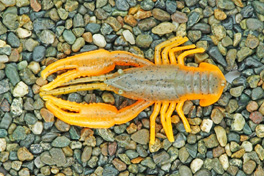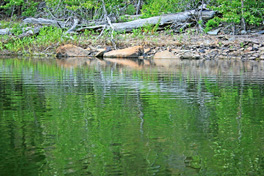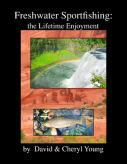Crawdads
I prefer to catch my crawdads fresh from the body of water that I’m fishing. To catch a bunch, make up five or six heavy mono lines and tie a piece of bacon on the end of each one. Throw each one out and let it settle on the bottom for a few minutes. Of course tie the free end onto a stick on the shore. Rotate by slowly retrieving each bacon strip, and net the craw dads instead of lifting them free of the water. Weight the bacon strip on the mono so it will stay on the bottom. Store them for the day in a container with one-half to one inch of water.

My preference is the smaller crawdads, the females with small claws. They seem to be taken more than the large ones. One and one-half inch size is ideal.
I hook these with a size 1 sharp Gamakatsu hook. I start by running the hook point through their nose and deep into the spine area and out the top of the thorax shell. Hooked this way, they stay alive and active. I prefer a heavy abrasion resistant leader, preferably

fluorocarbon. As an alternate mono I like maxima ultra green.
I use no weight and cast it out and let it settle down on its own. I let it sit for 30 seconds plus, and then pull gently with about a foot raise in the rod tip. I then continue this slow pull-and-stop retrieve. I wait until the fish runs, then I set the hook. Nearly all my fish are lip hooked; rarely do I gut hook a fish. This allows for a safe catch and release.
I seem to do best over rocky areas; crawdads live in the rocks and this is a good place to find a game fish that is foraging upon crawdads. However, these brush piles and heavy weed beds frustrate me with high numbers of snags. Once I pull upwards and it feels like it’s starting to snag, I drop the rod tip, hoping that the crawdad will free himself by crawling out of the snag. Many times this elicits an immediate strike. The crawdad is displaced, either on its side or upside down. It struggles to right itself. It is an easy catch for a fish.
Once the snag is freed, you’re most likely to have a strike. The problem with fishing this way is that you get a lot of snags. That’s why I use a 30# Fire-Line with a 30- inch, heavy, 20# fluorocarbon leader. With this setup I can usually pull out most snags. The hook’s sharpness must be tested after each snag. And of course you lose your crawfish. But it’s easy to re tie a single bait hook.
I use spinning tackle with a medium-light 6 1/2’ or 7’ rod. The 30# Fire-Line is very thin and easy to cast with a spinning reel.
It seems like every large fish living in your lake enjoys eating small crawfish. Largemouth and smallmouth bass, big panfish, walleye, and all species of trout love to eat crawdads. A crawdad to them is like an invite to the Red Lobster.

© 2026 The Gale Group, Inc. All rights reserved.
© 2026 Perigee Learning LLC. All rights reserved.
LoveTheOutdoors.com is owned and operated by Advameg, Inc. © 2026 Advameg, Inc.
Camping Adventures • Dutch Oven Cooking • Sports Knots
Fly Tying • Freshwater Fishing • Fly Fishing

